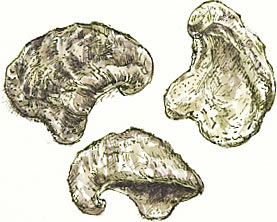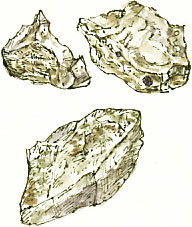 THIS FOSSIL SHELL of Gryphaea (drawn from three different angles, left) was lying amongst the gravel in a dry creek bed near Lampasas, Texas. Barbara spotted it when we were staying with Rheba and Farris four years ago.
THIS FOSSIL SHELL of Gryphaea (drawn from three different angles, left) was lying amongst the gravel in a dry creek bed near Lampasas, Texas. Barbara spotted it when we were staying with Rheba and Farris four years ago.Wild West Yorkshire, Thursday 18 November 2010
previous | this month | next
 THIS FOSSIL SHELL of Gryphaea (drawn from three different angles, left) was lying amongst the gravel in a dry creek bed near Lampasas, Texas. Barbara spotted it when we were staying with Rheba and Farris four years ago.
THIS FOSSIL SHELL of Gryphaea (drawn from three different angles, left) was lying amongst the gravel in a dry creek bed near Lampasas, Texas. Barbara spotted it when we were staying with Rheba and Farris four years ago.
Gryphaea was a kind of fossil oyster that lived from the late Triassic to the Jurassic. This one is less worn than the Gryphaea fossils that l've picked up on the Yorkshire coast and the flange down one side of the shell has been preserved. Gryphaea was a bivalve and this was its lower valve - anatomically the left valve - of the mollusc; here I've drawn it upside down. The smaller upper - or right - valve, which has become detached from this shell, acted as a lid.
I'd always thought that the thickened shell must have been primarily for defence but, because Gryphaea lived on softer parts of the seabed rather than attached to rocks, the extra thickness served to raise it above turbulence.
Also from the dry creek bed in Texas, these three flints (right). Flint may have formed from the concentration of silica rich fluids in cavities in sediments that were to form limestone. The source of this silica might have been the flinty spicules that made up the 'skeletons' of sponges.
Richard Bell, illustrator
previous | this month | Wild West Yorkshire home page | next